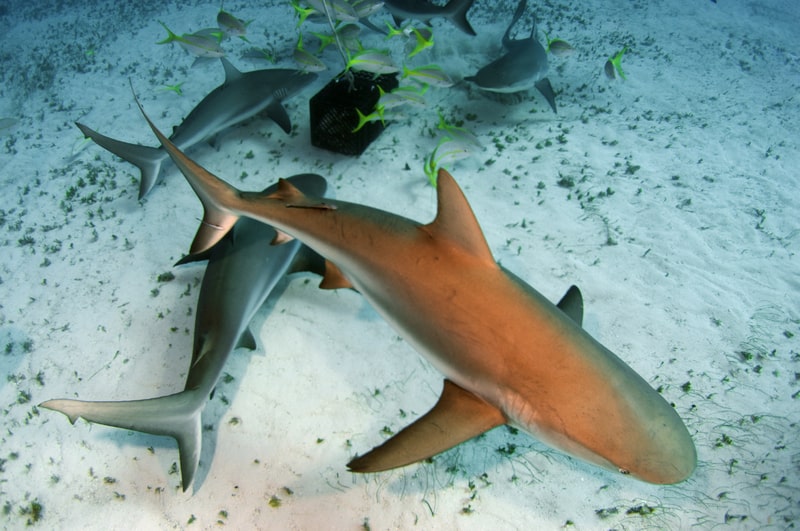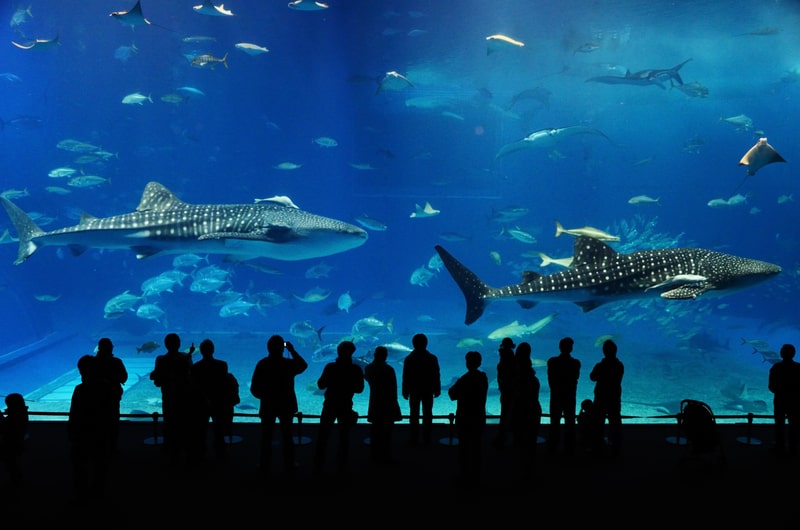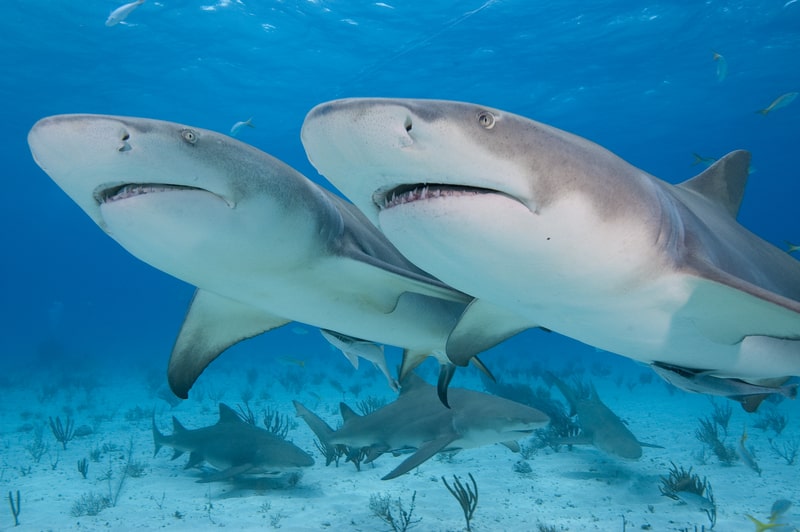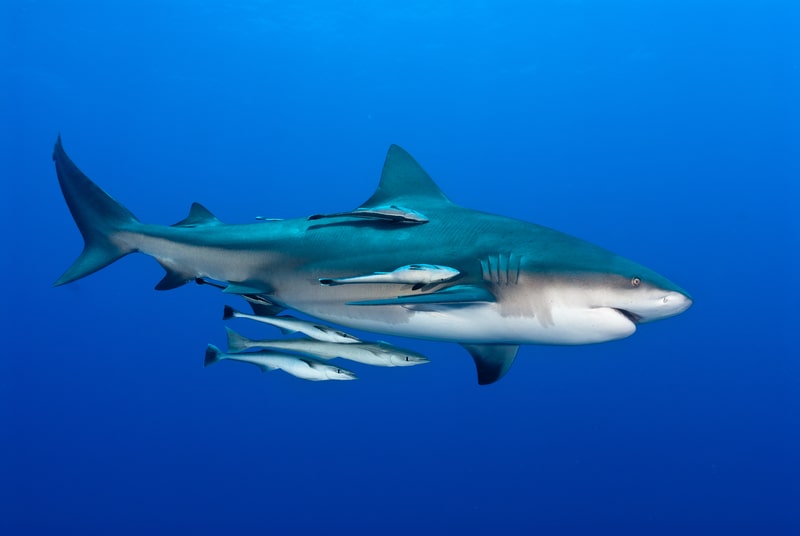Last updated on May 5th, 2023
Sharks rule the seas with an iron jaw. They swim at the top of the food chain with few rivals to their throne. It’s hard to match their strength, speed, and agility. As apex predators, they are excellent indicators of ocean health for scientists. However, these creatures are no match for humans who are almost hunting them to extinction. Conservationists are leading the efforts to save sharks and maintain ecological balance. Some have even made friends with sharks, defying all expectations. It reveals a fascinating side to these predators that usually evoke fear and dread.
51 Interesting facts about sharks
Facts about shark anatomy
1. Lethal Bite
Shark teeth look menacing from afar, but they are even worse up-close. Imagine up to 7 rows of teeth along their gums, and up to 300 teeth in total. Yikes.
2. Teeth-generating Machines
Sharks can go through 30,000 teeth over a lifetime. If they lose some while hunting, they will quickly grow new ones to replace these. A few species can replace entire rows at once for a fresh start. No dentures needed here.

3. Diet Secrets Revealed
Sharks with flat teeth crush shellfish, while those with pointed teeth grip fish. Sharks flashing sharp teeth with jagged edges use these tools to hunt large prey.
4. Extra Protection
Did you know that sharks wear a corset? Their dermal corset is a flexible outer skeleton made from collagen fibers. It shields them from skin damage, parasites, and turbulence. Squids and dolphins have similar skin protection.
5. Inner Skeleton
Unlike bony fish, shark skeleton is made from soft cartilage. It’s more flexible and less dense than bone, helping sharks swim faster while consuming less energy. This is one of the shark facts about their speed and agility.
6. Shark Fins

Shark fins are excellent swimming accessories. They ensure precise underwater movements. Most species have eight: pairs of pectoral fins, pelvic fins, and dorsal fins, plus an anal fin and a caudal fin.
7. Massive Liver
Shark liver takes up 25% of their bodyweight. It stores the energy they need to swim long distances. The oil inside also helps with buoyancy, like an internal life vest.
8. Ampullae of Lorenzini
Radar? Sharks don’t need that. They have jelly-filled pores that detect electromagnetic fields, helping them navigate the oceans and hunt at night.
9. Countershading Camouflage
Sharks generally have dark backs and white bellies. This countershading is a form of camouflage. From the top, they are as dark as the water. From the bottom, they mimic the light on the surface.
10. Dual Water Entry
Like other fish, sharks use their gills to extract oxygen from water. The liquid usually enters through the mouth, but they also have a spiracle hole at the top of their head. It doesn’t hurt to have an alternative. This fact about sharks highlights their anatomy that helps them survive.

Shark facts about shark origin
11. What’s in a Name?
“Shark” came from the Dutch “schurk”, a word that describes a villain, a scoundrel, and a predator – quite fitting for this frightening fish, as well as human equivalents like loan sharks.
12. Mariner’s Best Friend
Sharks weren’t always seen as enemies. Up until the 16th century, mariners called them “sea dogs” – possibly due to their curiosity, playfulness, and pack-hunting strategy. Indeed, some species are called dogfish and porbeagle.
13. Closest Living Relatives
You might think that sharks are closest to whales or dolphins, but DNA studies reveal more similarities with the rays – large flat fishes with wide pectoral fins that look like underwater wings.
14. Shark Diversity
We have identified over 500 species so far, and many more are waiting to be discovered. Some are positively tiny at just 6.7 inches, while others stretch up to 40 feet.

15. Biggest Fish in the Sea
Ancient sharks make modern ones look tame. Around 20 million years ago, you could’ve seen an 80 ft Megalodon terrorizing the oceans and swallowing prey whole with its 10 ft mouth.
16. Ancient Midwestern Sharks
About 370 million years ago, much of North America was a shallow ocean. Scientists dug up fossils of shark ancestors called the “Cladoselache” around Ohio, Kentucky, and Tennessee.
17. Ancient Shark versus Flying Dinosaur
While examining the fossil of a Pteranodon, scientists noticed a tooth stuck to the spine. It was traced to the Cretoxyrhina mantelli, an ancestor of the great white shark with a similar size. It’s an amazing snapshot of the ancient struggle for dominance at sea.
18. Aftermath of Dinosaur Meteor 66 MYA
Sharks were almost wiped out along with the dinosaurs. Up to 80% didn’t survive the meteor hit, but shark population bounced back quickly and new species evolved to replace the losses.

19. Mystery Extinction Event
It’s a mystery that baffles scientists. Around 70% – 90% of shark population disappeared 19 million years ago from sediment records, yet non-shark fish were largely unaffected. There are no known environmental changes or large predators during the time.
20. Human Activity
Humans are the biggest threat these days. Industrial fishing led to a 70% population decline in the past five decades, with 100 million catches per year. Conservationists are reversing this through fishing bans, shark sanctuaries, and global conventions.
Shark facts about shark behaviours
21. Shark Pack
Sharks have a reputation for being solitary hunters, but they often form groups to overwhelm prey. Schools of fish move quickly to avoid these ocean bullies.
22. Threat Display
Sharks don’t always bite right away. If you approach too closely, they’ll make exaggerated swimming movements to show their agitation. It would be wise to back off.

23. Attack Avoidance
Sharks have poor eyesight, so they might think that shiny objects are fish scales. That’s why scientists tell people not to wear jewelry at sea. It’s also a good idea to avoid waters with lots of fish because sharks may come to feed.
24. First Dibs
A social hierarchy exists between different species. For example, silky sharks are aggressive predators, but they are meek in the presence of powerful oceanic whitetip sharks. They back off instead of competing for food.
25. Tail Whip
Sharks don’t always chase after prey with their mouths. Some have learned to use their powerful tails, stunning prey with a strong flick before swooping in to feed.
26. Learning by Observation

Kids imitate adults. It’s true for both humans and sharks. In a study, young lemon sharks paired with trained sharks pick up skills faster than those with untrained partners.
27. Love Bites
Love hurts, literally, when it comes to sharks. During mating season, males may bite females to show their interest. Females develop thicker skin to withstand these bites.
28. Unconscious Swimmers
On the list of amazing shark facts, this fact will enthral you. Just as humans can sleep walk, sharks can sleep swim. It’s a necessity for breathing. Continuous forward motion ensures that water flows to their gills. With the brain effectively turned off, the spinal cord takes over to control their movement.
29. Bite and Run
Sharks play it safe. They tend to avoid violent struggles. After conducting a “test bite”, they move away and wait for prey to weaken before coming back to feed. During shark attacks, people can use this chance to flee from the predator if they can.

30. Shark Protector
A school of fish under a big shark, swimming in harmony. Seems unlikely, but it has been photographed in Australia. Small silver jacks are too small for sharks to be interested, so the fish school under them knowing that other predators won’t dare to get close. Smart.
Shark facts about shark senses and reproduction
31. Environmental Adaptation
Sharks living in murky waters can’t rely on vision, so they developed large olfactory bulbs for keen smell. They can detect even the faintest traces of blood in the water – around one part per million of seawater.
32. Scent Detection
Scents don’t usually hit shark nostrils at the same time. They hit one side before the other, allowing these creatures to figure out the direction of their prey. It’s comparable to how human ears work with sound.
33. No Blinking

Sharks don’t need to blink. They depend on the surrounding water to clean their eyes. During hunts, some species use a protective membrane as eye shields. Meanwhile, great white sharks roll their eyes backward for safety.
34. Color Blind
Many sharks have good night vision, but they can’t distinguish between colors. Some can see green and grey, which isn’t that much better. To detect objects, they rely on the contrast with the background.
35. Sharp Senses
Sharks can detect frequencies between 20 to 1000 hertz. Small openings on their head lead to an inner ear. As fish, they also have a lateral line that sense vibrations, water speed, and pressure changes.
36. Preferred Habitat
Sharks are present in all seas. Only a few can live in freshwater. They are known to dive up to 3,700 meters deep, but most don’t venture lower than 2,000 meters. They move to shallow sheltered areas with abundant food to give birth.
37. Virgin Birth
While most sharks mate to produce offspring, some females can conceive without males. It was confirmed through genetic fingerprinting. The process is called parthenogenesis, and it’s in fact common among animals except mammals. This is one of the most interesting shark facts!
38. Shark Birth
It’s quality over quantity for sharks. Unlike bony fish, sharks give birth to only a few offspring per cycle. Fertilized eggs typically hatch inside the mother’s body and come out as live pups. A few species lay eggs in the water and protect these with a leather-like case — often called a “mermaid’s purse”.
39. Cannibal Babies
Survival of the fittest happens even before birth. The first embryos to hatch eat the remaining sleepy eggs or even their smaller siblings. These practices are called oophagy (“eating eggs”) and adelphophagy (“eating one’s brother”). It speeds up their development so they come out as large pups.
40. Gestation
It’s a long wait for spiny sharks. They hold the record for longest gestation among all vertebrates. Females take 22 to 24 months from fertilization to birth. Maturity will take many more years, with most sharks reaching this stage within 13 to 15 years.
41. Lifespan
With enough food and no predators, sharks often live 20 to 30 years. Some are known to reach over 100 years, with the Greenland shark having the longest lifespan at 400 years.

Sharks and Humans
42. Hawaiian Mythology
Fishermen thought that the dead could turn into animals. If they see similarities between a shark’s markings and an ancestor’s clothes, they’ll give it food and treat it as a family god. In return, the shark drive fish into their net and save them from danger.
43. Shark Tattoo
Jason Momoa, a Hawaiian actor famous for playing Arthur Curry in Aquaman and Khal Drogo in Game of Thrones, has a shark tattoo on his left forearm dedicated to his family god or aumakua.
44. Fijian Mythology
In Fiji, people believe in the shark-god Dakuwaqa who protects fishermen at sea. He is a shape-shifter, but his real form is a muscular man with the torso of a shark.
. . . continue reading facts about sharks on the next page
